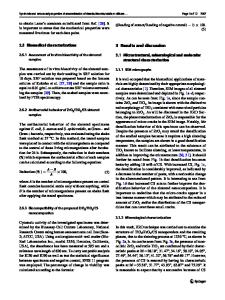Synthesis and Properties of Poly(Vinyl Alcohol)/Calcium Aluminate Nanocomposites
- PDF / 1,007,055 Bytes
- 7 Pages / 420.48 x 639 pts Page_size
- 53 Downloads / 367 Views
SYNTHESIS AND PROPERTIES OF POLY(VINYL ALCOHOL)/ CALCIUM ALUMINATE NANOCOMPOSITES PHILLIP B. MESSERSMITH AND SAMUEL I. STUPP University of Illinois, Department of Materials Science and Engineering, 1304 W. Green St., Urbana, IL 61801.
ABSTRACT This paper describes the synthesis, structure and properties of a new layered nanocomposite which may have applications in cementitious systems. This material is one example of a new class of materials which consist of inorganic crystals containing intercalated organic polymer. The nanocomposite is synthesized by precipitating Ca2AI(OH)6[X].nH20 (X=OH-, C03-2 ) in the presence of poly(vinyl alcohol) (PVA). X-ray diffraction analysis indicates that the nanocomposite consists of calcium aluminate layers separated by interlayers containing anions, water and PVA. The intercalation of PVA can only be accomplished during crystal growth and is accompanied by an expansion in layer spacing from -8 A to -18 A. The nanocomposite exhibited enhanced thermal stability and when compacted into a cylinder was found to have more than twice the compressive strength than the pure calcium aluminate. INTRODUCTION We are interested in synthesizing novel composite materials in which organic polymers are molecularly dispersed in the microstructure of inorganic crystalline phases. Our approach to achieve intimate polymer dispersion is to nucleate and grow inorganic crystals from homogeneous solutions containing the polymer chains as co-solutes. Because the ceramic crystals are grown in the presence of macromolecules there is an opportunity to control crystal size, morphology and structure. During crystal growth polymer molecules can be incorporated into the crystal structure and opportunistically occupy sites such as grain boundaries or other two dimensional defects, nanopores, lattice channels or interlamellar spaces. In such a material one may realistically expect changes in crystal morphology and physical properties such as thermal stability and resistance to crystal fracture, in addition to opening up new avenues for the processing of ceramics. We refer to the resulting molecularly dispersed composites as organoceramics. This work reports on the synthesis of tetracalcium aluminate-based organoceramics containing poly(vinyl alcohol) (PVA). Because hydraulic cementitious materials generally rely on crystal formation during the setting reaction and polymers such as PVA are sometimes included in cement formulation we believe there may be some use for these organoceramics (or others like them) in cementitious systems. MATERIALS AND METHODS The synthesis of tetracalcium aluminate used here is based on a modification of the method developed by Carlson (1) to synthesize various calcium aluminates from solution. In this method, known amounts of a supersaturated calcium aluminate solution and a saturated calcium hydroxide solution are mixed together to form tetracalcium aluminate hydrate. We have modified this technique by simply including dissolved poly(vinyl alcohol)(PVA)(99.7% hydrolyzed, Mv = 60,100) d
Data Loading...











